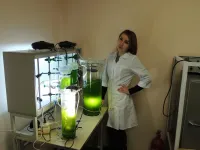(Press-News.org) SARS-CoV-2 mutations similar to those in the B1.1.7 UK variant could arise in cases of chronic infection, where treatment over an extended period can provide the virus multiple opportunities to evolve, say scientists.
Writing in Nature, a team led by Cambridge researchers report how they were able to observe SARS-CoV-2 mutating in the case of an immunocompromised patient treated with convalescent plasma. In particular, they saw the emergence of a key mutation also seen in the new variant that led to the UK being forced once again into strict lockdown, though there is no suggestion that the variant originated from this patient.
Using a synthetic version of the virus Spike protein created in the lab, the team showed that specific changes to its genetic code - the mutation seen in the B1.1.7 variant - made the virus twice as infectious on cells as the more common strain.
SARS-CoV-2, the virus that causes COVID-19, is a betacoronavirus. Its RNA - its genetic code - is comprised of a series of nucleotides (chemical structures represented by the letters A, C, G and U). As the virus replicates itself, this code can be mis-transcribed, leading to errors, known as mutations. Coronaviruses have a relatively modest mutation rate at around 23 nucleotide substitutions per year.
Of particular concern are mutations that might change the structure of the 'spike protein', which sits on the surface of the virus, giving it its characteristic crown-like shape. The virus uses this protein to attach to the ACE2 receptor on the surface of the host's cells, allowing it entry into the cells where it hijacks their machinery to allow it to replicate and spread throughout the body. Most of the current vaccines in use or being trialled target the spike protein and there is concern that mutations may affect the efficacy of these vaccines.
UK researchers within the Cambridge-led COVID-19 Genomics UK (COG-UK) Consortium have identified a particular variant of the virus that includes important changes that appear to make it more infectious: the ΔH69/ΔV70 amino acid deletion in part of the spike protein is one of the key changes in this variant.
Although the ΔH69/ΔV70 deletion has been detected multiple times, until now, scientists had not seen them emerge within an individual. However, in a study published today in Nature, Cambridge researchers document how these mutations appeared in a COVID-19 patient admitted to Addenbrooke's Hospital, part of Cambridge University Hospitals NHS Foundation Trust.
The individual concerned was a man in his seventies who had previously been diagnosed with marginal B cell lymphoma and had recently received chemotherapy, meaning that that his immune system was seriously compromised. After admission, the patient was provided with a number of treatments, including the antiviral drug remdesivir and convalescent plasma - that is, plasma containing antibodies taken from the blood of a patient who had successfully cleared the virus from their system. Despite his condition initially stabilising, he later began to deteriorate. He was admitted to the intensive care unit and received further treatment, but later died.
During the patient's stay, 23 viral samples were available for analysis, the majority from his nose and throat. These were sequenced as part of COG-UK. It was in these sequences that the researchers observed the virus's genome mutating.
Between days 66 and 82, following the first two administrations of convalescent sera, the team observed a dramatic shift in the virus population, with a variant bearing ΔH69/ΔV70 deletions, alongside a mutation in the spike protein known as D796H, becoming dominant. Although this variant initially appeared to die away, it re-emerged again when the third course of remdesivir and convalescent plasma therapy were administered.
Professor Ravi Gupta from the Cambridge Institute of Therapeutic Immunology & Infectious Disease, who led the research, said: "What we were seeing was essentially a competition between different variants of the virus, and we think it was driven by the convalescent plasma therapy.
"The virus that eventually won out - which had the D796H mutation and ΔH69/ΔV70 deletions - initially gained the upper hand during convalescent plasma therapy before being overtaken by other strains, but re-emerged when the therapy was resumed. One of the mutations is in the new UK variant, though there is no suggestion that our patient was where they first arose."
Under strictly-controlled conditions, the researchers created and tested a synthetic version of the virus with the ΔH69/ΔV70 deletions and D796H mutations both individually and together. The combined mutations made the virus less sensitive to neutralisation by convalescent plasma, though it appears that the D796H mutation alone was responsible for the reduction in susceptibility to the antibodies in the plasma. The D796H mutation alone led to a loss of infection in absence of plasma, typical of mutations that viruses acquire in order to escape from immune pressure.
The researchers found that the ΔH69/ΔV70 deletion by itself made the virus twice as infectious as the previously dominant variant. The researchers believe the role of the deletion was to compensate for the loss of infectiousness due to the D796H mutation. This paradigm is classic for viruses, whereby escape mutations are followed by or accompanied by compensatory mutations.
"Given that both vaccines and therapeutics are aimed at the spike protein, which we saw mutate in our patient, our study raises the worrying possibility that the virus could mutate to outwit our vaccines," added Professor Gupta.
"This effect is unlikely to occur in patients with functioning immune systems, where viral diversity is likely to be lower due to better immune control. But it highlights the care we need to take when treating immunocompromised patients, where prolonged viral replication can occur, giving greater opportunity for the virus to mutate."
INFORMATION:
The research was largely supported by Wellcome, the Medical Research Council, the National Institute of Health Research, and the Bill and Melinda Gates Foundation.
Reference
Kemp, SA et al. SARS-CoV-2 evolution during treatment of chronic infection. Nature; 5 Feb; DOI: 10.1038/s41586-021-03291-y
Scientists at the Francis Crick Institute have found important structural similarities between SARS-CoV-2 and a pangolin coronavirus, suggesting that a pangolin coronavirus could infect humans.
While SARS-CoV-2 is thought to have evolved from a bat coronavirus, its exact evolutionary path is still a mystery. Uncovering its history is challenging as there are likely many undiscovered bat coronaviruses and, due to differences between bat coronaviruses and SARS-CoV-2, it is thought that the virus may have passed to humans via at least one other species.
In their study, published in Nature Communications, the scientists compared the structures of the spike proteins found on ...
A banking crisis is often seen as a self-fulfilling prophecy: The expectation of bank failure makes it happen. Picture people lining up to withdraw their money during the Great Depression or customers making a run on Britain's Northern Rock bank in 2007.
But a new paper co-authored by an MIT professor suggests we have been missing the bigger picture about banking crises. Yes, there are sometimes panics about banks that create self-reinforcing problems. But many banking crises are quieter: Even without customers panicking, banks can suffer losses serious enough to create subsequent economy-wide downturns.
"Panics are not needed for banking crises to have severe economic consequences," says Emil Verner, the MIT professor who helped lead the study. "But ...
Plastics made from crops such as maize or sugarcane instead of fossil fuels are generally considered sustainable. One reason is that plants bind CO2, which compensates for the carbon released into the atmosphere when plastics are disposed. However, there is a catch: With increasing demand for raw materials for bioplastic production, the areas under cultivation may not be sufficient. As a result, natural vegetation is often converted to agricultural land and forests are cut down. This in turn releases large amounts of CO2. The assumption that more bioplastics does not necessarily lead to more climate protection has now been confirmed by researchers at the University of Bonn ...
A study from the Center for Phage Technology, part of Texas A&M's College of Agriculture and Life Sciences and Texas A&M AgriLife Research, shows how the "hidden" genes in bacteriophages -- types of viruses that infect and destroy bacteria -- may be key to the development of a new class of antibiotics for human health.
The study has been published in Nature Communications and Current Science Daily, as well as featured in a recent Nature Research Microbiology Community blog post.
The need for new antibiotics
Antibiotic-resistant bacteria pose ...
Primeval forests are of great importance for biodiversity and global carbon and water cycling. The three-dimensional structure of forests plays an important role here because it influences processes of gas and energy exchange with the atmosphere, whilst also providing habitats for numerous species. An international research team led by the University of Göttingen has investigated the variety of different complex structures that can be found in the world's forests, as well as the factors that explain this diversity. The results have been published in Nature Communications.
The researchers investigated the structure of primeval ...
A vegan diet is more effective for weight loss than a Mediterranean diet, according to a groundbreaking new study that compared the diets head to head. The randomized crossover trial, which was END ...
Rain falls lightly on the ocean's surface. Marine mammals chirp and squeal as they swim along. The pounding of surf along a distant shoreline heaves and thumps with metronomic regularity. These are the sounds that most of us associate with the marine environment. But the soundtrack of the healthy ocean no longer reflects the acoustic environment of today's ocean, plagued with human-created noise.
A global team of researchers set out to understand how human-made noise affects wildlife, from invertebrates to whales, in the oceans, and found overwhelming evidence that marine fauna, and their ecosystems, are negatively ...
In the framework of the Chlorella microalgae cultivation process, the researchers from Peter the Great St.Petersburg Polytechnic University (SPbPU) obtained microalgae biomass with a high content of carotenoid pigments, which is suitable for the food industry. The research results were published Nov. 2020 in the scientific journal "Agronomy Research".
The deterioration of the ecological status of urban areas and the industrialization of the food industry requires the additional enrichment of the diet with biologically valuable food substances. Such pigments as carotenoids, from which vitamin A is synthesized in the body, are ...
Astronomers have for the first time used distant galaxies as 'scintillating pins' to locate and identify a piece of the Milky Way's missing matter.
For decades, scientists have been puzzled as to why they couldn't account for all the matter in the universe as predicted by theory. While most of the universe's mass is thought to be mysterious dark matter and dark energy, 5 percent is 'normal matter' that makes up stars, planets, asteroids, peanut butter and butterflies. This is known as baryonic matter.
However, direct measurement has only accounted for about half ...
Using AI and computer automation, Technion researchers have developed a "conjecture generator" that creates mathematical conjectures, which are considered to be the starting point for developing mathematical theorems. They have already used it to generate a number of previously unknown formulas. The study, which was published in the journal Nature, was carried out by undergraduates from different faculties under the tutelage of Assistant Professor Ido Kaminer of the Andrew and Erna Viterbi Faculty of Electrical Engineering at the Technion.
The project deals with one of the most fundamental elements of mathematics - mathematical constants. ...


